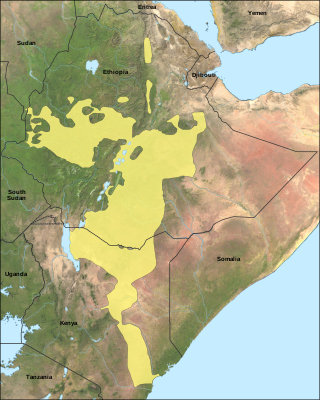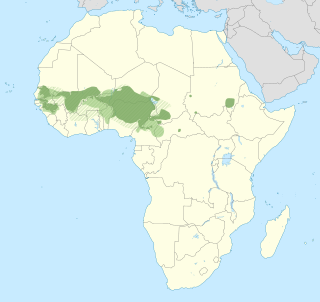Related Research Articles

The Kordofanian languages are a geographic grouping of five language groups spoken in the Nuba Mountains of the South Kordofan region of Sudan: Talodi–Heiban languages, Lafofa languages, Rashad languages, Katla languages and Kadu languages. The first four groups are sometimes regarded as branches of the hypothetical Niger–Congo family, whereas Kadu is now widely seen as a branch of the proposed Nilo-Saharan family.

Oromo, historically also called Galla, which is regarded by the Oromo as pejorative, is an Afroasiatic language that belongs to the Cushitic branch. It is native to the Ethiopian state of Oromia and northern Kenya and is spoken predominantly by the Oromo people and neighboring ethnic groups in the Horn of Africa. It is used as a lingua franca particularly in the Oromia Region and northeastern Kenya.

Udmurt is a Permic language spoken by the Udmurt people who are native to Udmurtia. As a Uralic language, it is distantly related to languages such as Finnish, Estonian, Mansi, Khanty, and Hungarian. The Udmurt language is co-official with Russian within Udmurtia.
Marquesan is a collection of East-Central Polynesian dialects, of the Marquesic group, spoken in the Marquesas Islands of French Polynesia. They are usually classified into two groups, North Marquesan and South Marquesan, roughly along geographic lines.

Akan is the largest language of Ghana, and the principal native language of the Akan people, spoken over much of the southern half of Ghana. About 80% of Ghana's population speak Akan as a first or second language, and about 44% of Ghanaians are native speakers. Akan is also spoken across the border in parts of Côte d'Ivoire.

Fula, also known as Fulani or Fulah, is a Senegambian language spoken by around 36.8 million people as a set of various dialects in a continuum that stretches across some 18 countries in West and Central Africa. Along with other related languages such as Serer and Wolof, it belongs to the Atlantic geographic group within Niger–Congo, and more specifically to the Senegambian branch. Unlike most Niger-Congo languages, Fula does not have tones.
Phuthi (Síphùthì) is a Nguni Bantu language spoken in southern Lesotho and areas in South Africa adjacent to the same border. The closest substantial living relative of Phuthi is Swati, spoken in Eswatini and the Mpumalanga province of South Africa. Although there is no contemporary sociocultural or political contact, Phuthi is linguistically part of a historic dialect continuum with Swati. Phuthi is heavily influenced by the surrounding Sesotho and Xhosa languages, but retains a distinct core of lexicon and grammar not found in either Xhosa or Sesotho, and found only partly in Swati to the north.
Yakkha is a language spoken in parts of Nepal, Darjeeling district and Sikkim. The Yakkha-speaking villages are located to the East of the Arun river, in the southern part of the Sankhuwasabha district and in the northern part of the Dhankuta district of Nepal. About 14,000 people still speak the language, out of 17,003 ethnic Yakkha in Nepal. Genealogically, Yakkha belongs to the Eastern Kiranti languages and is in one subgroup with several Limbu languages, e.g. Belhare, Athpare, Chintang and Chulung. Ethnically however, the Yakkha people perceive themselves as distinct from the other Kiranti groups such as Limbu.

The Tarahumara language is a Mexican Indigenous language of the Uto-Aztecan language family spoken by around 70,000 Tarahumara (Rarámuri/Ralámuli) people in the state of Chihuahua, according to a 2002 census conducted by the government of Mexico.
Western Ojibwa is a dialect of the Ojibwe language, a member of the Algonquian language family. It is spoken by the Saulteaux, a subnation of the Ojibwe people, in southern Manitoba and southern Saskatchewan, Canada, west of Lake Winnipeg. Saulteaux is generally used by its speakers, and Nakawēmowin is the general term in the language itself.
Komo is a Nilo-Saharan language spoken by the Kwama (Komo) people of Ethiopia, Sudan and South Sudan. It is a member of the Koman languages. The language is also referred to as Madiin, Koma, South Koma, Central Koma, Gokwom and Hayahaya. Many individuals from Komo are multilingual because they are in close proximity to Mao, Kwama and Oromo speakers. Komo is closely related to Kwama, a language spoken by a group who live in the same region of Ethiopia and who also identify themselves as ethnically Komo. Some Komo and Kwama speakers recognize the distinction between the two languages and culture, whereas some people see it as one "ethnolinguistic" community. The 2007 Ethiopian census makes no mention of Kwama, and for this reason its estimate of 8,000 Komo speakers may be inaccurate. An older estimate from 1971 places the number of Komo speakers in Ethiopia at 1,500. The Komo language is greatly understudied; more information is being revealed as researchers are discovering more data about other languages within the Koman family.

The Nias language is an Austronesian language spoken on Nias Island and the Batu Islands off the west coast of Sumatra in Indonesia. It is known as Li Niha by its native speakers. It belongs to the Northwest Sumatra–Barrier Islands subgroup which also includes Mentawai and the Batak languages. It had about 770,000 speakers in 2000. There are three main dialects: northern, central and southern. It is an open-syllable language, which means there are no syllable-final consonants.
Sukuma is a Bantu language of Tanzania, spoken in an area southeast of Lake Victoria between Mwanza, Shinyanga, and Lake Eyasi.
Moro is a Kordofanian language spoken in the Nuba Mountains of South Kordofan, Sudan. It is part of the Western group of West Central Heiban Kordofonian languages and belongs to the Niger-Congo phylum. In 1982 there were an estimated 30,000 Moro-speakers. This was before the second Sudan civil war and therefore the recent number of speakers might differ. There can be noted an influence of Arabic and it is suspected that today approximately a fourth of all Moro vocabulary has a relation or an origin in the Arabic language.
The Kwaio language, or Koio, is spoken in the centre of Malaita Island in the Solomon Islands. It is spoken by about 13,000 people.
Maia is a Papuan language spoken in the Madang Province of Papua New Guinea, and is a member of the Trans-New Guinea language family. It has a language endangerment status of 6a, which means that it is a vigorous and sustainable language spoken by all generations. According to a 2000 census, there are approximately 4,500 living speakers of the language, who are split between twenty-two villages in the Almani district of the Bogia sub-district.
Nding is a (critically) endangered Niger–Congo language in the Talodi family of Kordofan, Sudan.
Amonap, also known as Apalakiri, is a Cariban language spoken by the Kuikuro and Kalapalo peoples of Brazil, and formerly by the Matipu. It is spoken in seven villages along the Culuene River in the Xingu Indigenous Park of Mato Grosso.
Tungag, or Lavongai, is an Austronesian language of New Ireland Province, Papua New Guinea, localized New Hanover, the native name of which is Lavongai.
Nuaulu is a language indigenous to the island of Seram Island in Indonesia, and it is spoken by the Nuaulu people. The language is split into two dialects, a northern and a southern dialect, between which there a communication barrier. The dialect of Nuaulu referred to on this page is the southern dialect, as described in Bolton 1991.
References
- 1 2 Katla at Ethnologue (25th ed., 2022)

- ↑ Katla language at Ethnologue (17th ed., 2013)

- 1 2 3 Birgit Hellwig 2013, p. 238.
- 1 2 Tucker, Archibald N.; Bryan, Margaret A. (1966). The Katla Group. In Linguistic Analyses: The Non-Bantu Languages of North-Eastern Africa: London: Oxford University Press.
- 1 2 Nüsslein, Ulrike (2020). A Grammar of Kordofanian Julut with Particular Consideration of the Verbal Morphology. Köln: Köppe. pp. 30–31.
- ↑ Meinhof 1917, p. 219.
- 1 2 Meinhof 1917, p. 221.
- 1 2 Meinhof 1917, p. 212-235.